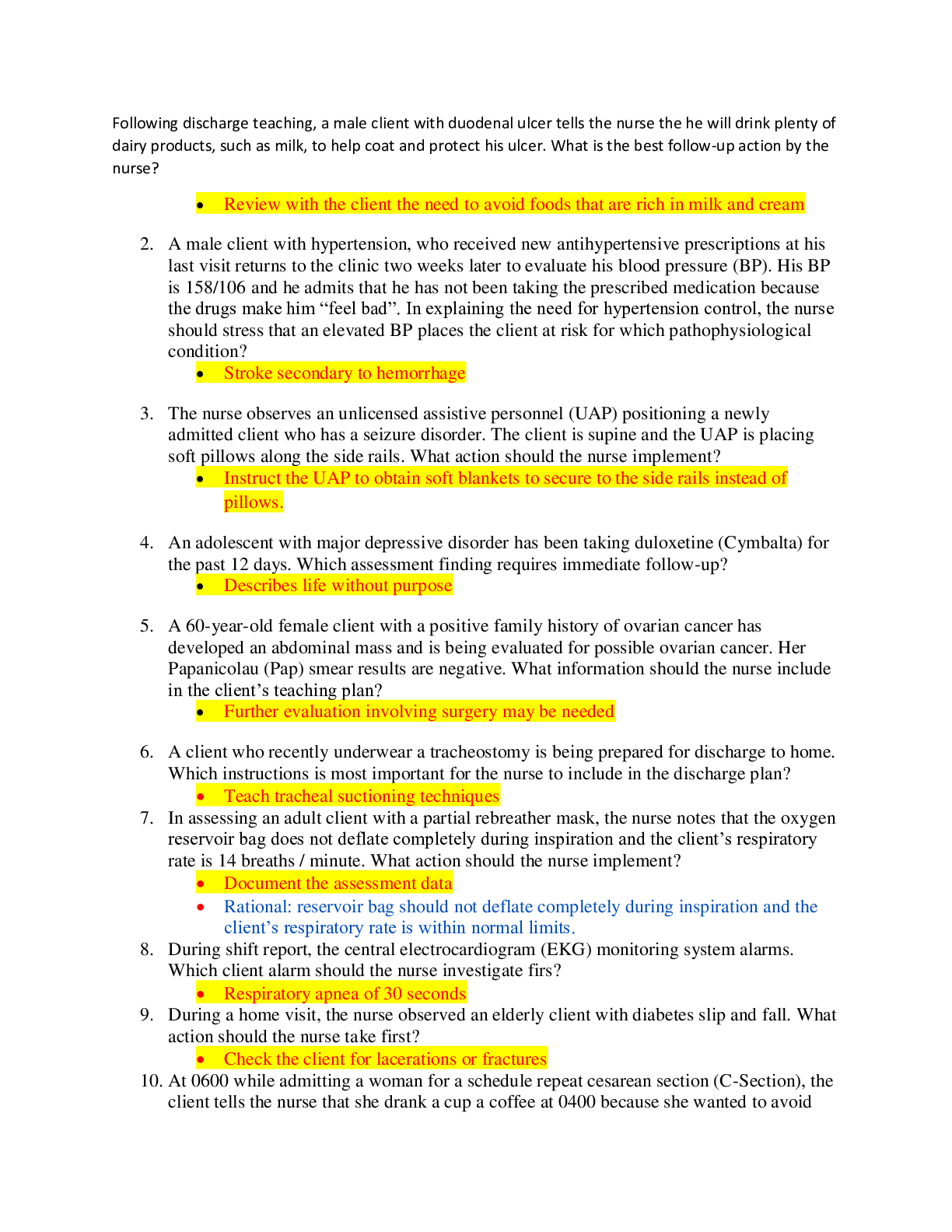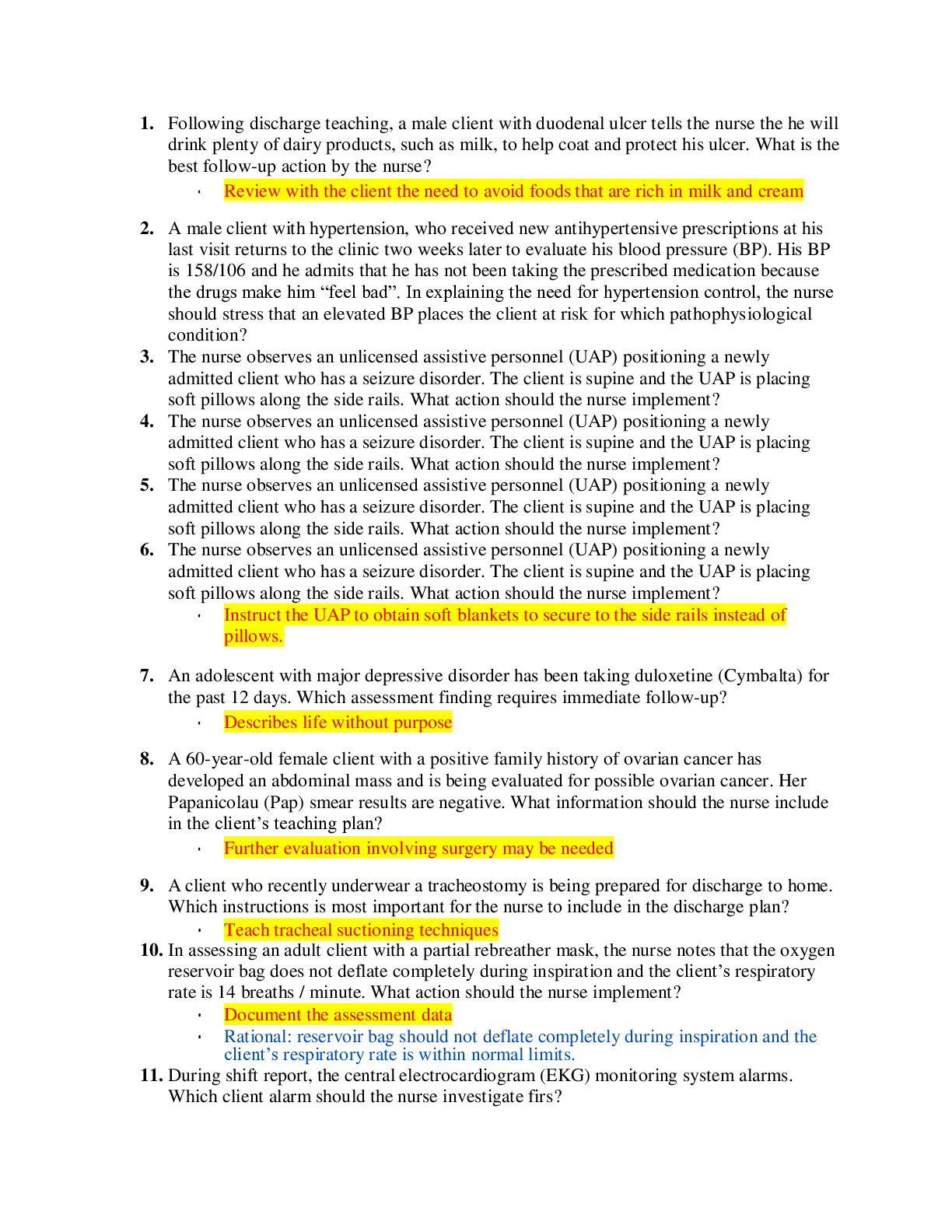*NURSING > HESI MED SURG > MED SURG 2 HESI TOPICS (All)
MED SURG 2 HESI TOPICS
Document Content and Description Below
Critical Care/ Basic Nursing Skills/ Safety/ ICU Confusion 480, 618 People on ventilation are more prone to ICU confusion b/c of sleep deprivation, secluded rooms. Drug calc mL/hr to mcg/min Nitr ... oglycerin Cardiovascular/ sinus bradycardia/ recognize Rate are less than 60 P and QRS width are within normal limits Low heart rate is normal for some people but with people with decreased cardiac output, treatment is needed. Assess patient for syncope, dizziness, confusion, hypotension, diaphoresis, SOB, chest pain TX: Find out the cause of the bradycardia (maybe their meds), Admin O2 if needed, admin atropine sulfate to increase heart rate, monitor for hypotension and admin fluids IV. The client might need a pacemaker Cardiovascular/ V-fib/ Interpret Ventricles fire in a totally disorganized manner. Client lacks a pulse, BP, respirations, and heart sounds Cardiac emergency Irregular undulations of varying amplitudes No cardiac output TX: CPR, defib, anti-dysrhythmic drugs Neuro and Resp/ Subdural Hematoma/ ET Suction No more than 3 times; 10- 15 Seconds; May need hyperventilation for up to 3 minutes before suction to prevent hypoxia. In patients with severe head trauma, ET suctioning may cause adverse reactions including cough, systemic HTN, increased ICP and reduced cerebral perfusion pressure (Found on the internet) ET Suction is used to clear airway of secretions when the cough reflex is suppressed by the ET tube. Resp/ Chest tube/ deep breathing You want to encourage coughing and deep breathing Assist pt. to deep breathe, cough, perform maximal sustained inhalations and use incentive spirometry. Asses breathing effectiveness by pulse ox Professional issues/ Document/ Leadership/ STEMI Post thrombolysis/ Lidocaine Before administering lidocaine, always check the vial label to prevent administering a form that contains epinephrine or preservatives because these solutions are used for local anesthesia only. May need double verification Monitor ECG strip, VS Drug Calc/ units/kg/ heparin bolus Basic Nursing Skills/ HIV/ Candidiasis Standard precautions include washing hands even if gloves have been worn to give care. Wear exam gloves for touching blood or body fluids or any non-intact body surface Mouth care can improve appetite; rinse pt. mouth with sodium bicarb w/ sterile H2O or NS several times a day. Use soft toothbrush and drink plenty of fluids. Avoid using alcohol-based mouthwashes. Wear gowns during procedure that might generate splashes (changing clients w/ diarrhea) Use mask when droplets may be dispersed (suctioning) Basic Nursing Skills/ Esophageal Varices/ diet Soft diet, if bleeding they are NPO, no hard candy Med Administration/ teaching/ Addison’s/ Discharge plan Needs lifelong hormone replacement Need for close medical supervision Needs medical alert bracelet S/S of overdosage and underdoasge of medication Diet: High sodium, low potassium, and high carb (complex carb) Fluid: At least 3 L of fluid per day GI/ Hepatic/ Oncology/ Colon Cancer/ Intestinal polyps Risk factors for colon cancer include previous colorectal polyps, history of colorectal cancer. Cardiovascular/ Acute Coronary syndrome/ Cardiac Enzymes Elevations in troponins and myoglobin indicate myocardial injury or infarction. Troponin: <0.10 ng/mL Onset(as early as 1 hr post injury) Peak(10-24hrs) Return to normal(5-14 days) Myoglobin: <90 mcg/L Onset (1-4 hr) Peak(12hr) Return to normal(24hr) CK-MB: Onset(4-8hrs) Peak (12-24) Return to normal(48-72) Ordered every 6 hours. Cardiovascular/ dysrhythmias/calcium Common causes of dysrhythmias include acid base and electrolyte imbalances (potassium, calcium, and magnesium) Hypocalcemia: can cause Ventricular dysrhythmia, prolonged ST and QT intervals, and cardiac arrest Hypercalcemia: can cause shortened ST segment and widened T wave, atrioventricular block, tachycardia or bradycardia, digitalis hypersensitivity, and cardiac arrest.*** Cardiovascular/MI/ female Woman more commonly experience dyspnea, unusual fatigue, and sleep disturbances Cardiovascular/GI and hepatic/ Septic Shock/ Peritonitis pg1171 MS Rigged board like abdomen When treatment is delayed, blood vessel dilation continues. The body responds to the continuing infectious process by shunting extra blood to the area of inflammation. Fluid is shifted from the extracellular fluid compartment into the peritoneal cavity connective tissues and GI tract (third spacing). The shift can lead to hypovolemic shock. Causes of Peritonitis: Abdominal pain, tenderness, and distention. Decreased LOC and urine output Cardiovascular/operative/AAA/ Pulse Absent Ruptured AAA=loss of pulses distal to the rupture Cardiovascular and renal/AKI (Acute renal failure) pg 74(HESI) Daily Weights, Monitor I&0’s, monitor serum urine, potassium levels and ECG changes. Asses LOC, Kayexalate may be prescribed if K is too high. Clients with renal failure retain sodium. With water retention, the sodium becomes diluted and serum levels may appear near normal. With excessive water retention, the sodium levels appear decreased (dilution). Limit fluid and sodium intake in AKI clients. [Show More]
Last updated: 3 years ago
Preview 1 out of 8 pages
.png)
Buy this document to get the full access instantly
Instant Download Access after purchase
Buy NowInstant download
We Accept:

Reviews( 0 )
$8.00
Can't find what you want? Try our AI powered Search
Document information
Connected school, study & course
About the document
Uploaded On
Mar 23, 2021
Number of pages
8
Written in
All
Additional information
This document has been written for:
Uploaded
Mar 23, 2021
Downloads
0
Views
122





 Test Bank.png)



.png)





